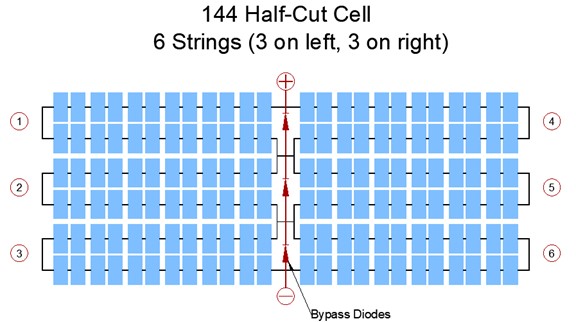Featured Insights
Solar PV Systems and Shading
Solid objects, such as chimneys, building elevations, trees, dirt etc. cause shading on the PV modules. These objects may return as remarkable energy losses in the Solar PV system energy generation. Therefore, it is very crucial to perform site and simulation analysis before starting installation works.
It is very important to manage non-uniform shading especially for the rooftop Solar PV applications. The local shading may also cause side effects as damaging the Solar PV system and the facility where the PV system is built on.

To understand in detail, we need to figure out how Solar PV modules and the PV arrays function.
How PV Modules Operate
Solar PV modules do have cells, which are sensitive to solar irradiation. The cells within the PV Modules are connected in series and parallel, with different number of bypass diodes.
A typical commercial 550 Wp Half-Cut Solar PV module has 144 cells. The PV cells are divided into six groups and wired in parallel to the 3 individual bypass diodes. In a half cut Solar PV module the cells are wired in series with six parallel groups to increase the voltage as figured below. All the PV cells and the diode groups are brought together to form a Solar PV Module with positive and negative terminals.

Shading Effect
PV Module Level
When a cell is not generating power due to the shading, it will not be able to generate the same amount of current that other unshaded cells generate. Due to the series connection of the cells, the total current of the cell string will be as small as the weakest cell. As a result, that will create power loss due to the current limitation.
As illustrated in the figure above, there are bypass diodes (red triangle) across the cells to protect the modules and cells from the hot spot and improve the PV module performance.
Due to economic reasons the manufacturers do not put bypass diodes to each cell. As it is seen in the figure above, the PV module is divided into 6 groups of cells and each of the two groups of cell string has one bypass diode.
If one cell is shaded, the string with the shaded cell will not contribute to the total voltage and power of the module. Therefore, we can estimate that the module might lose roughly 17% of the total output power by bypassing the shaded cell string through a bypass diode, which is illustrated in the figure below.

Array Level
To increase the voltage level of a Solar PV system, the PV modules are connected in series. Serially connected PV modules form the arrays, and the length of the arrays vary depending on panel voltage and inverter limits.
The I-V curve of an array looks the same as the individual I-V curve of each PV module. The voltage of a PV array is scaled to the number of PV modules connected in series while the current stays the same as the individual PV module’s current.
Regarding bypass diode function in a PV array, when one module is shaded, the entire PV array can lose power by rate of limited current from shaded PV module. As mentioned above, the bypass diode will minimize the shading effect by bypassing the shaded PV module. Therefore, the loss will be limited to the size of the PV module.
